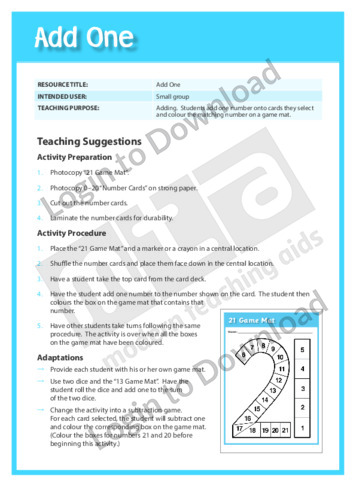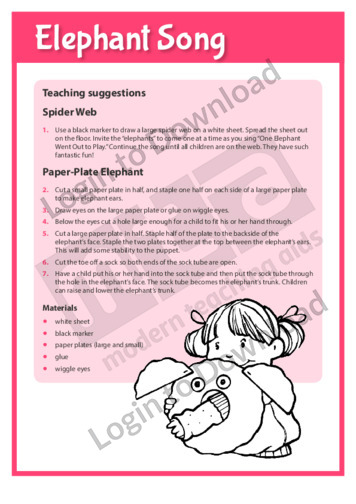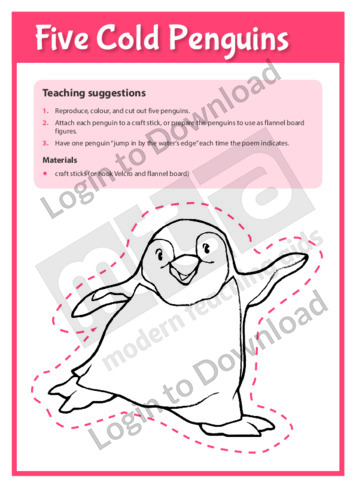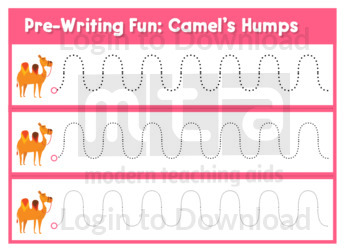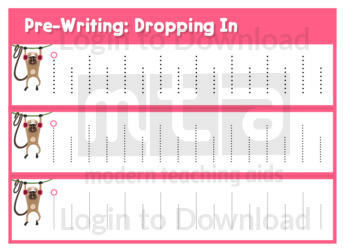This template, ‘Decorate An Easter Egg’ is a simple resource that can be used to easily celebrate Easter in the classroom. Two egg templates are provided and students are asked to decorate the eggs by colouring between the lines. The coloured in eggs create a simple and effective art and craft task that can be …More
This maths activity, ‘Add One’ develops basic maths skills by encouraging students to add the number 1 to selected number cards. It is aimed at developing students’ knowledge of adding. It provides a 21 game mat, a 13 game mat and number cards.
This quick reference chart, ‘Addition Chart’ can be reproduced for classroom use.
This diagnostic Assessment Item, ‘Alphabet Checklist’ can be used to assess students’ skills in alphabet recognition.
This Assessment Item, ‘Alphabet Recognition Checklist’ provides a form teachers can use to record students’ alphabet knowledge over two assessments.
This template, ‘Cutting Curved Lines’ helps students develop their fine motor skills when using scissors. This resource provides students with the opportunity to practise cutting along different types of curved lines including tight curves and more wavy curves.
This template, ‘Cutting Straight Lines’ helps students develop their fine motor skills when using scissors. This resource provides students with the opportunity to practise cutting along different types of straight lines including dotted lines, solid lines and coloured straight lines.
This template, ‘Cutting Waves’ helps students develop their fine motor skills when using scissors. This resource provides students with the opportunity to practise cutting along different types of waved lines including narrow waves and wider, looser waves. Students are then asked to practise their gluing skills by selecting a wave to paste over the boats …More
This template, ‘Cutting Zig Zag Lines’ helps students develop their fine motor skills when using scissors. This resource provides students with the opportunity to practise cutting along different types of zig zagged lines including dotted lines, solid lines and coloured zig zag lines.
This early learning activity, ‘Elephant Song’ provides instructions on how to make elephant puppets using paper plates and socks and is followed by an accompanying song.
This early learning activity, ‘Five Cold Penguins’ provides instructions on how to make penguin stick puppets followed by an accompanying song.
This early learning activity, ‘Five Little Fishes’ provides instructions on how to make whale and fish models followed by an accompanying song.
This early learning activity, ‘Five Little Monkeys’ provides cut-outs to make monkey stick puppets followed by an accompanying song.
This early learning activity, ‘Gingerbread Girl’ provides cut-outs to make stick puppets of characters that feature in the accompanying story.
This Assessment Item, ‘High Frequency Words’ features a list of commonly used words arranged into three sets. It supports reading, writing and vocabulary development.
This set of flashcards, ‘High Frequency Words’ supports vocabulary development through recognition of high frequency words. High frequency words are quite simply words that most frequently occur in early encounters with reading and writing. Many high frequency words are difficult for children to sound out phonetically and must therefore be learnt by sight. Working with …More
This set of flashcards, ‘High Frequency Words’ supports vocabulary development through recognition of high frequency words. High frequency words are quite simply words that most frequently occur in early encounters with reading and writing. Many high frequency words are difficult for children to sound out phonetically and must therefore be learnt by sight. Working with …More
This set of flashcards, ‘High Frequency Words’ supports vocabulary development through recognition of high frequency words. High frequency words are quite simply words that most frequently occur in early encounters with reading and writing. Many high frequency words are difficult for children to sound out phonetically and must therefore be learnt by sight. Working with …More
This set of flashcards, ‘High Frequency Words’ supports vocabulary development through recognition of high frequency words. High frequency words are quite simply words that most frequently occur in early encounters with reading and writing. Many high frequency words are difficult for children to sound out phonetically and must therefore be learnt by sight. Working with …More
This set of flashcards, ‘High Frequency Words’ supports vocabulary development through recognition of high frequency words. High frequency words are quite simply words that most frequently occur in early encounters with reading and writing. Many high frequency words are difficult for children to sound out phonetically and must therefore be learnt by sight. Working with …More
This set of flashcards, ‘High Frequency Words’ supports vocabulary development through recognition of high frequency words. High frequency words are quite simply words that most frequently occur in early encounters with reading and writing. Many high frequency words are difficult for children to sound out phonetically and must therefore be learnt by sight. Working with …More
This set of flashcards, ‘High Frequency Words’ supports vocabulary development through recognition of high frequency words. High frequency words are quite simply words that most frequently occur in early encounters with reading and writing. Many high frequency words are difficult for children to sound out phonetically and must therefore be learnt by sight. Working with …More
This set of flashcards, ‘High Frequency Words’ supports vocabulary development through recognition of high frequency words. High frequency words are quite simply words that most frequently occur in early encounters with reading and writing. Many high frequency words are difficult for children to sound out phonetically and must therefore be learnt by sight. Working with …More
This Assessment Item, ‘High-Frequency Words Assessment’ can be used by teachers to record the words a student knows on sight, on three occasions.
This sequencing activity, ‘How Many?’ develops comprehension through sequencing images about counting and understanding numbers.
This motivational award, ‘I Can Safely Use Scissors!’ is a certificate that can be printed and distributed to students. Use this award to encourage students to behave safely and responsibly in the classroom.
This motivational award, ‘I Can Safely Use Scissors!’ is a certificate that can be printed and distributed to students. Use this award to encourage students to behave safely and responsibly in the classroom.
This motivational award, ‘I Cut Perfectly!’ is a certificate that can be reproduced for classroom use. Use this award to encourage students to focus on improving their cutting skills and to take pride in their neat work.
This diagnostic Assessment Item, ‘Letter Recognition Checklist’ can be used to assess students’ skills in alphabet recognition.
This worksheet, ‘Letters AB’ encourages students to practise their handwriting and formation of the lower case and capital letters A and B.
This worksheet, ‘Letters CD’ encourages students to practise their handwriting and formation of the lower case and capital letters C and D.
This worksheet, ‘Letters EF’ encourages students to practise their handwriting and formation of the lower case and capital letters E and F.
This worksheet, ‘Letters GH’ encourages students to practise their handwriting and formation of the lower case and capital letters G and H.
This worksheet, ‘Letters IJ’ encourages students to practise their handwriting and formation of the lower case and capital letters I and J.
This worksheet, ‘Letters KL’ encourages students to practise their handwriting and formation of the lower case and capital letters K and L.
This worksheet, ‘Letters MN’ encourages students to practise their handwriting and formation of the lower case and capital letters M and N.
This worksheet, ‘Letters OP’ encourages students to practise their handwriting and formation of the lower case and capital letters O and P.
This worksheet, ‘Letters QR’ encourages students to practise their handwriting and formation of the lower case and capital letters Q and R.
This worksheet, ‘Letters ST’ encourages students to practise their handwriting and formation of the lower case and capital letters S and T.
This worksheet, ‘Letters UV’ encourages students to practise their handwriting and formation of the lower case and capital letters U and V.
This worksheet, ‘Letters WX’ encourages students to practise their handwriting and formation of the lower case and capital letters W and X.
This worksheet, ‘Letters YZ’ encourages students to practise their handwriting and formation of the lower case and capital letters Y and Z.
This reading activity, ‘Match Letters’ provides opportunities for practice with matching capital letters to their lower case letters.
This reading activity, ‘Match Letters’ provides opportunities for practice with matching capital letters to their lower case letters.
This reading activity, ‘Match Letters’ provides opportunities for practice with matching lower case letters to their capital letters.
This reading activity, ‘Match Letters’ provides opportunities for practice with matching lower case letters to their capital letters.
This maths manipulative, ‘Number Words’ can be reproduced for classroom use.
This quick reference chart, ‘Numbers 0-9’ can be reproduced for classroom use.
This worksheet, ‘Number 1-10’ encourages students to practise their handwriting and formation of the numbers 1-10.
This full-colour ‘Self-Correcting Puzzle: Alphabet’ is a great hands-on vocabulary building activity for early learners. Each puzzle card can be cut into three pieces for students to then match up the letter of the alphabet with a common word and corresponding picture. This is a fun and engaging exercise for developing letter recognition and word …More
This full-colour ‘Self-Correcting Puzzle: Vocabulary’ is a great hands-on vocabulary building activity for early learners. Each puzzle card can be cut in half for students to then match up the word with the corresponding picture. This is a fun and engaging exercise for developing word and picture association skills. The 26 puzzle cards are formatted …More
This diagnostic Assessment Item, ‘Stages of Emergent Writing’ can be used to assess students’ handwriting skills.
This maths template, ‘What Time Is It?’ can be reproduced for classroom use.
This hands-on activity supports educators in guiding young learners through the process of making a bee-friendly waterer, using simple materials that provide an additional sensory element. The activity begins with some question prompts for educators to engage children’s existing knowledge about bees and encourage them to consider their habitat and needs. Educators are then provided …More
This ‘Pre-Writing Fun: Blowing Bubbles’ activity is perfect for supporting students in practising an important pre-writing shape. The activity provides decreasingly thick lines for students to follow with their pen or pencil to practise the shape, allowing them more independence and more opportunity to develop their pen control skills as they progress. A pink circle …More
This ‘Pre-Writing Fun: Bouncing Roo’ activity is perfect for supporting students in practising an important pre-writing shape. The activity provides decreasingly thick lines for students to follow with their pen or pencil to practise the shape, allowing them more independence and more opportunity to develop their pen control skills as they progress. A pink circle …More
This ‘Pre-Writing Fun: Butterfly Dance’ activity is perfect for supporting students in practising an important pre-writing shape. The activity provides decreasingly thick lines for students to follow with their pen or pencil to practise the shape, allowing them more independence and more opportunity to develop their pen control skills as they progress. A pink circle …More
This ‘Pre-Writing Fun: Camel’s Humps’ activity is perfect for supporting students in practising an important pre-writing shape. The activity provides decreasingly thick lines for students to follow with their pen or pencil to practise the shape, allowing them more independence and more opportunity to develop their pen control skills as they progress. A pink circle …More
This ‘Pre-Writing Fun: Criss Cross Cat’ activity is perfect for supporting students in practising an important pre-writing shape. The activity provides decreasingly thick lines for students to follow with their pen or pencil to practise the shape, allowing them more independence and more opportunity to develop their pen control skills as they progress. A pink …More
This ‘Pre-Writing Fun: Dropping In’ activity is perfect for supporting students in practising an important pre-writing shape. The activity provides decreasingly thick lines for students to follow with their pen or pencil to practise the shape, allowing them more independence and more opportunity to develop their pen control skills as they progress. A pink circle …More
It�s that easy!


